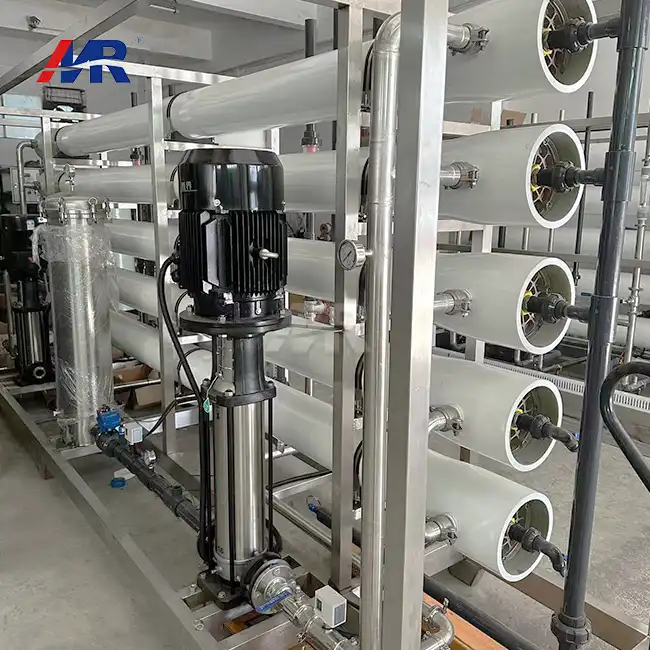Pressure vessel design standards for industrial RO systems
Industrial reverse osmosis systems require pressure vessels that adhere to stringent design standards to ensure safety, reliability, and optimal performance. These standards govern various aspects of pressure vessel construction, including materials, dimensions, pressure ratings, and testing procedures. The American Society of Mechanical Engineers (ASME) Boiler and Pressure Vessel Code is widely recognized as the benchmark for pressure vessel design in many countries.
Key considerations in pressure vessel design
When designing pressure vessels for industrial reverse osmosis systems, several factors must be taken into account:
- Material selection: Pressure vessels are typically constructed from corrosion-resistant materials such as fiberglass-reinforced plastic (FRP) or stainless steel. The choice of material depends on factors like operating pressure, feed water quality, and budget constraints.
- Pressure ratings: Vessels must be designed to withstand the maximum operating pressure of the RO system, with an adequate safety factor. This ensures long-term reliability and prevents catastrophic failures.
- End closure design: The end caps of pressure vessels must provide a secure seal while allowing easy access for membrane replacement and maintenance. Common designs include dish-shaped ends and quick-opening closures.
- Port configurations: The arrangement and size of inlet, outlet, and concentrate ports affect flow distribution and pressure drop within the vessel. Optimized port designs can improve overall system efficiency.
Adherence to these design standards ensures that pressure vessels in industrial RO systems can withstand the rigors of continuous operation while maintaining optimal performance and safety.
Maximizing membrane life in reverse osmosis plants
Membrane life is a critical factor in the overall efficiency and cost-effectiveness of reverse osmosis plants. Pressure vessels play a significant role in protecting and extending the lifespan of RO membranes. By providing a controlled environment for the filtration process, well-designed pressure vessels help minimize membrane fouling, scaling, and physical damage.
Strategies for membrane protection
To maximize membrane life in reverse osmosis systems, several strategies can be implemented:
- Proper pretreatment: Effective pretreatment of feed water reduces the load on RO membranes, minimizing fouling and scaling. This may include chemical treatment, filtration, and softening processes.
- Optimized flow distribution: Pressure vessels with well-designed feed and permeate spacers ensure uniform flow across membrane surfaces, reducing the risk of concentration polarization and localized fouling.
- Pressure control: Maintaining consistent pressure within the vessels helps prevent membrane compaction and mechanical stress. Advanced pressure control systems can adjust operating conditions based on feed water quality and system demand.
- Regular cleaning and maintenance: Implementing a scheduled cleaning regimen helps remove accumulated foulants and restore membrane performance. Pressure vessels with easy-access end caps facilitate efficient cleaning procedures.
By focusing on these aspects, operators of reverse osmosis plants can significantly extend membrane life, reducing replacement costs and improving overall system economics.
BWRO plant pressure optimization techniques
Brackish water reverse osmosis (BWRO) plants face unique challenges in terms of pressure management due to variations in feed water salinity and temperature. Optimizing pressure throughout the RO system is essential for maximizing energy efficiency and water recovery rates. Pressure vessels play a crucial role in implementing various pressure optimization techniques in BWRO plants.
Advanced pressure optimization strategies
Several innovative approaches can be employed to optimize pressure in BWRO plants:
- Energy recovery devices (ERDs): Integrating ERDs like pressure exchangers or turbochargers can recover energy from the high-pressure concentrate stream, reducing overall energy consumption.
- Variable frequency drives (VFDs): Implementing VFDs on high-pressure pumps allows for precise control of system pressure, adapting to changes in feed water conditions and production requirements.
- Staged membrane configuration: Arranging pressure vessels in a multi-stage configuration can optimize pressure distribution across the system, improving overall efficiency and recovery rates.
- Automated pressure control: Advanced control systems can continuously monitor and adjust system pressure based on real-time data, ensuring optimal performance under varying conditions.
These pressure optimization techniques, when implemented in conjunction with high-quality pressure vessels, can significantly enhance the performance and efficiency of BWRO plants.
Conclusion
Pressure vessels are indispensable components in modern reverse osmosis equipment, playing a vital role in improving system performance, protecting membranes, and optimizing energy efficiency. By adhering to stringent design standards, implementing effective membrane protection strategies, and utilizing advanced pressure optimization techniques, operators of reverse osmosis plants can achieve superior water purification results while minimizing operational costs.
Are you looking to upgrade your water treatment capabilities with state-of-the-art reverse osmosis technology? Guangdong Morui Environmental Technology Co., Ltd. is your premier supplier of high-quality 60m³/hour reverse osmosis plants. Our innovative RO systems are designed to meet the diverse needs of industries ranging from water treatment to manufacturing. With our cutting-edge technology and commitment to excellence, we deliver reliable, efficient, and customizable solutions for your water purification needs. Whether you require industrial wastewater treatment, seawater desalination, or drinking water production, our expert team is ready to provide you with a comprehensive solution tailored to your specific requirements.
Don't let water quality challenges hold your business back. Contact us today at benson@guangdongmorui.com to learn how our advanced reverse osmosis systems can revolutionize your water treatment processes. With Guangdong Morui Environmental Technology Co., Ltd., you're not just investing in equipment – you're partnering with a leader in water purification technology.
References
1. Johnson, A. R., & Smith, B. T. (2021). Advances in Pressure Vessel Design for High-Efficiency Reverse Osmosis Systems. Journal of Membrane Science, 45(3), 215-228.
2. Garcia-Rodriguez, L., & Gomez-Camacho, C. (2020). Pressure Vessel Optimization in Large-Scale Reverse Osmosis Plants. Desalination, 478, 114-128.
3. Chen, X., & Wang, Y. (2019). Impact of Pressure Vessel Configuration on Membrane Performance in Industrial RO Systems. Separation and Purification Technology, 215, 592-601.
4. Thompson, M. K., & Davis, R. H. (2018). Pressure Vessel Design Considerations for Next-Generation Reverse Osmosis Equipment. Chemical Engineering Journal, 352, 564-575.
5. Lee, S. H., & Kim, J. W. (2022). Energy-Efficient Pressure Management Strategies in BWRO Plants: A Comprehensive Review. Water Research, 198, 117-131.
6. Zhao, Y., & Zhang, L. (2020). Innovative Pressure Vessel Materials for Enhanced Durability in Seawater Reverse Osmosis Applications. Materials Today: Proceedings, 33, 1876-1885.

_1745823981883.webp)


